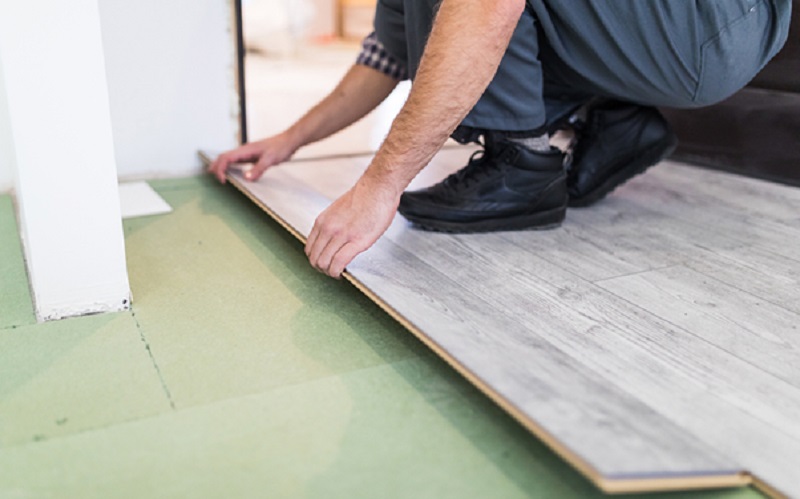
Getting started with resilient flooring can feel straightforward on the surface, but there’s more to it than selecting a finish and placing an order. From understanding material behaviour to aligning with long-term sustainability goals, this guide breaks down how to approach it practically.
For those aiming to build or renovate responsibly, resilient flooring plays a vital role in balancing durability with environmental considerations. Whether applied in homes, offices or public buildings, its flexibility, lifecycle performance and ease of upkeep make it a strong candidate for modern spaces.
Below is a beginner’s guide that lays out key steps for integrating resilient flooring into your project in a way that works.
1. Understand What Makes Flooring ‘Resilient’
The term refers to floor types that offer a degree of flexibility or ‘bounce back’ when pressure is applied. This category includes vinyl, rubber, linoleum, and cork-based products. These materials resist dents and wear, making them suitable for high-traffic or multi-purpose environments. They also tend to offer more acoustic comfort than hard tiles or concrete, which matters in offices or upper-floor apartments. Before selecting a product, consider the setting: moisture-prone areas may benefit more from vinyl, while rubber is ideal for impact resistance.
2. Align Your Goals With the Right Material
Resilient flooring offers multiple options, but each serves a slightly different function. Luxury vinyl tiles mimic the look of wood or stone and are easy to clean, while linoleum leans towards natural, biodegradable ingredients. Your choice should depend on whether you’re prioritising design, longevity, acoustic comfort or ease of maintenance. Avoid selecting based on price alone, low-cost options might compromise quality or environmental performance. Instead, weigh the material’s total life cycle, including installation and eventual removal.
3. Prepare the Subfloor Correctly
A level and dry subfloor is non-negotiable. Any dips, uneven patches or moisture can shorten the flooring’s lifespan. Resilient materials are thin enough to reveal imperfections beneath them over time. Use appropriate levelling compounds and moisture barriers where needed. If the project involves retrofitting over old tiles or concrete, assess whether surface grinding or priming is necessary to ensure adhesion. This upfront step avoids failures down the road and helps maintain manufacturer warranties.
4. Explore Installation Methods Before You Decide
Depending on the material, installation may be fully glued, semi-loose lay, or click-and-lock. Each comes with different preparation needs and long-term performance expectations. For example, glue-down installations provide more permanent results but require precision and longer setting times. On the other hand, click-and-lock tiles allow faster work with less mess. If the area in question is commercial or high-traffic, a fixed system may be more appropriate. Discuss options with a supplier or contractor before committing.
5. Factor in Ongoing Maintenance Early On
Once installed, resilient flooring is generally low-maintenance but that doesn’t mean maintenance-free. Dirt and grit can still scratch the wear layer over time, and certain cleaning chemicals may break down protective coatings. Always match your cleaning routine to the material. Rubber surfaces, for instance, benefit from neutral pH cleaners, while vinyl can tolerate slightly more aggressive agents. Regular care keeps the material performing well and reduces the need for early replacement.
6. Tie Your Choice Back to Sustainable Construction Goals
Choosing resilient flooring contributes to sustainable construction when selected thoughtfully. Materials with recycled content, low volatile organic compound (VOC) emissions, or certified production processes support greener outcomes. In the midsection of any project discussion, it’s important to balance aesthetic, functional and environmental goals. Consult documentation like Environmental Product Declarations (EPDs) to better understand the full impact of your selection.
7. Check Compatibility With Other Building Elements
A resilient floor needs to work well with walls, skirting, underfloor heating and transitions. Think about how it will meet thresholds or stairs and how it reacts with adhesives, sealants or backing layers. Overlooking compatibility at the planning stage can cause rework, which undermines both budget and environmental targets. Seek confirmation from your installer or material provider that all systems will integrate smoothly.
8. Monitor Installation for Quality Assurance
Even the best flooring material can underperform if installation is rushed or inconsistent. Observe site conditions: is there proper acclimatisation of the product before laying? Has the subfloor been checked for humidity or movement? Is each panel aligned correctly? Don’t leave it entirely to installers, schedule checks and document the process where possible. This provides accountability and protects your investment.
9. Review Post-Installation Support and Warranties
Before finalising the job, go through the manufacturer’s warranty terms. Some warranties become void if specific installation or maintenance conditions aren’t followed. Understand how repairs or replacements are handled and what post-installation support is available. This step protects you long after the last tile is laid and helps in future renovations or resale conversations.
10. Speak With Material Experts or Suppliers Early
Getting guidance from flooring specialists saves time, avoids mismatched products, and ensures your selection supports broader project requirements. Informed suppliers can advise on the best type of resilient flooring for your needs and flag potential installation challenges ahead of time.
They can also help assess whether your choice aligns with current sustainability standards and local regulations. This kind of insight proves useful not just during installation, but also in long-term maintenance planning and lifecycle costing. Rather than relying on assumptions, a short conversation with the right expert can help you make better decisions, saving you time, resources and costly backtracking later.
Contact Mapei Far East to get expert support on resilient flooring options that promote long-term, sustainable construction goals.